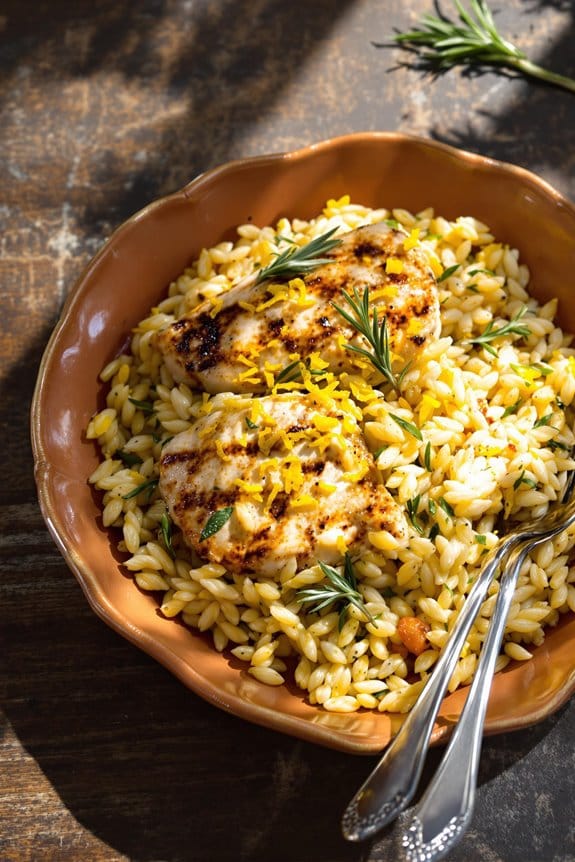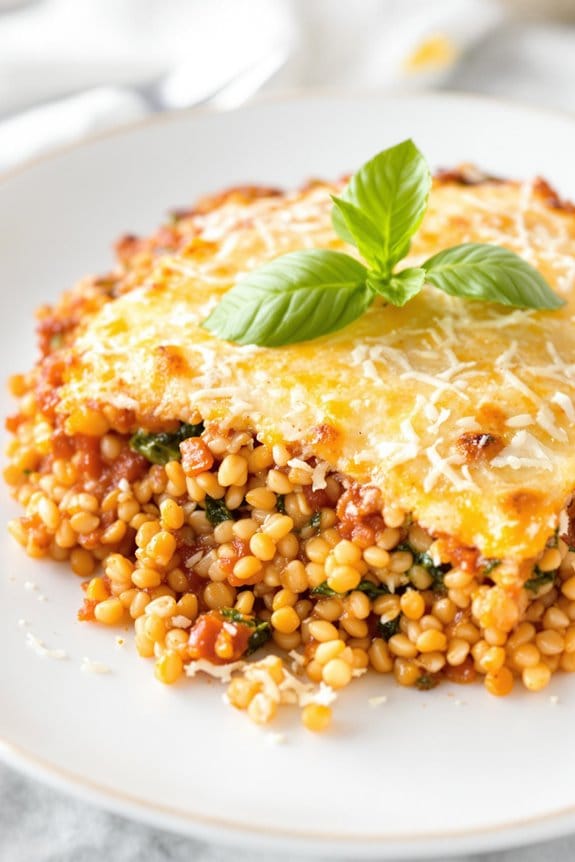Imagine you’re whisking together the perfect weeknight dinner: the Lemon Rosemary Orzo Skillet. With each stir, the toasted orzo mingles with freshly sautéed onions and a fragrance of rosemary fills the air, hinting at the rustic sophistication of this simple dish. The zest of lemon adds a bright note, promising a burst of flavor with every bite. As you sprinkle Parmesan over the golden hue of the skillet, consider how this dish balances robust flavors with delicate simplicity. Would you stick to the traditional recipe, or is there a personal twist you’d think might elevate it even further? Why not share your thoughts and find out what unique variations others might be cooking up?
History
Orzo, a form of short-cut pasta that resembles a large grain of rice, has been a staple in Mediterranean kitchens for centuries.
Initially, this pasta was likely a convenient option for its quick cooking time and versatility in various dishes. You can trace orzo‘s lineage back to ancient Italy, where pasta in similar shapes was prevalent amongst both the elite and common folk.
The Greeks also have a version, called kritharaki, engrained in their culinary traditions, often used in soups and stews.
The evolution of orzo reflects the cultural exchanges of the Mediterranean, where ingredients and recipes crisscrossed regions, influenced by both necessity and trade.
This pasta’s enduring presence highlights its adaptability and the timeless appeal it holds across various Mediterranean cuisines.
Recipe
Lemon Rosemary Orzo Skillet is a delightful dish that combines the light, citrusy notes of lemon with the aromatic fragrance of rosemary, creating a perfect blend for a comforting meal. This dish is incredibly versatile, suitable for a quick weeknight dinner yet elegant enough for a leisurely weekend brunch.
The orzo is cooked right in the skillet with other ingredients, absorbing all the flavors and making this a one-pot wonder. Not only is this recipe a breeze to prepare, but it also boasts a presentation that will impress your guests or family.
The combination of fresh lemon zest and rosemary brings a bright, invigorating touch to the creamy orzo, making it a dish that’s as invigorating as it’s satisfying. You can serve it as a main course or as a hearty side dish alongside your favorite protein.
Ingredients:
- 1 tablespoon olive oil
- 1 small onion, finely chopped
- 2 cloves garlic, minced
- 1 teaspoon fresh rosemary, chopped
- 1 cup orzo pasta
- 2 cups vegetable broth
- Zest and juice of 1 lemon
- 1/2 cup grated Parmesan cheese
- Salt and pepper, to taste
- Fresh parsley, for garnish
Cooking Instructions:
In a large skillet, heat olive oil over medium heat. Add the onion and sauté until softened. Stir in the garlic and chopped rosemary, cooking for about a minute until fragrant.
Pour in the orzo and toast lightly until golden. Slowly add the vegetable broth, stirring continuously. Allow the mixture to simmer until the orzo is tender and the liquid is mostly absorbed.
Finally, stir in the lemon zest, lemon juice, and Parmesan cheese. Season with salt and pepper to taste. Remove from heat once everything is well incorporated and the orzo is creamy.
Additional Tips:
For the best results, use freshly grated Parmesan as it melts better and adds a richer flavor to the dish compared to pre-grated cheeses.
If the orzo absorbs all the broth but still isn’t cooked to your liking, you can add a little more liquid and continue cooking. For a vegan option, skip the cheese or use a plant-based substitute.
Garnishing with fresh parsley not only adds a pop of color but also enhances the flavors. This dish pairs beautifully with a crisp white wine or a light-bodied red, making it perfect for an intimate dinner or a casual gathering.
Step 1. Prepare Ingredients and Tools
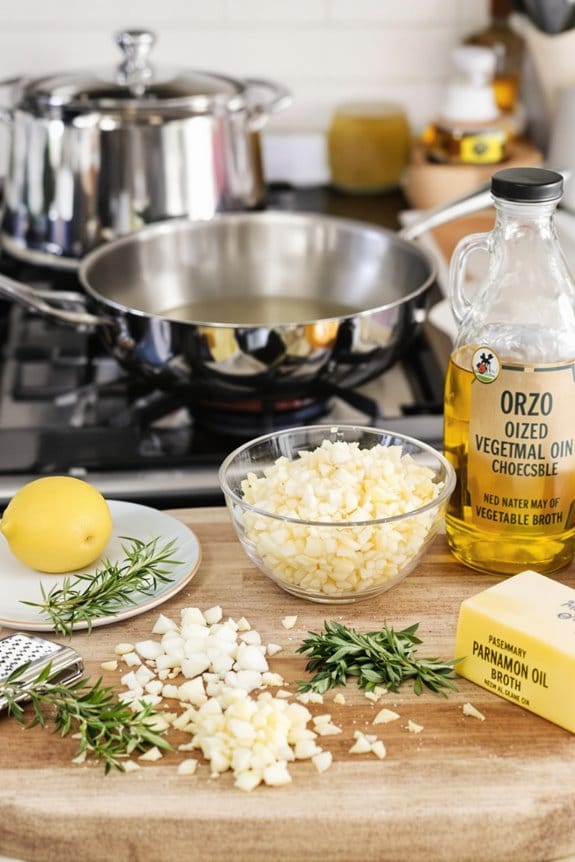
Before you begin cooking, gather all the necessary ingredients and tools to make the Lemon Rosemary Orzo Skillet.
You’ll need fresh rosemary, lemons, orzo pasta, chicken broth, and a selection of fresh vegetables.
Also, grab a large skillet, a sharp knife, a cutting board, and a measuring cup.
It’s handy to measure out the orzo and broth beforehand to streamline your cooking process.
Don’t forget to wash the vegetables and herbs; lemon should be zested and juiced, while rosemary needs a fine chop.
Organize everything within easy reach to make the process smoother.
This simple setup phase guarantees you’re not scrambling for items last minute, keeping your cooking experience calm and enjoyable.
[DIRECTIONS]:
Step 2. Saute Onions and Garlic

Begin by warming a tablespoon of olive oil over medium heat in your skillet.
Once it’s hot, add your finely chopped onion into the pan. You’ll want to stir it occasionally, allowing it to cook until it’s soft and translucent. This usually takes about 5 minutes.
Next, add your minced garlic to the skillet.
Garlic cooks faster, so keep stirring it with the onion for just about 1 to 2 minutes. You’re looking for a fragrant scent and a light golden color—be careful not to burn it, as that could introduce a bitter flavor to your dish.
This step is essential for building the aromatic foundation of your Lemon Rosemary Orzo Skillet, setting the stage for even more delicious additions.
Step 3. Add Rosemary and Lemon Zest
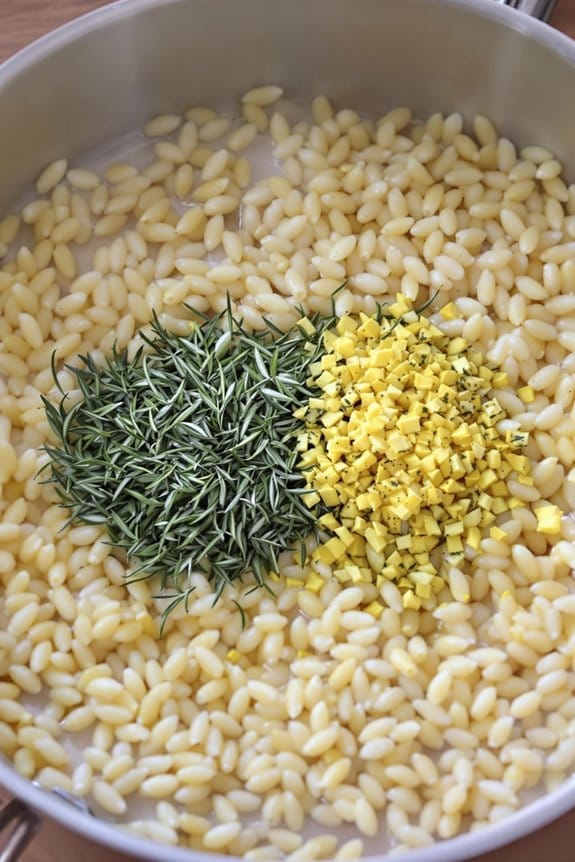
Now’s the time to enrich your dish with herbs and zest. Add fresh rosemary leaves, finely chopped, to infuse your skillet with its aromatic oils and piney flavor.
It’s key to strip the leaves from the woody stems before chopping to avoid any unpleasant textures. Alongside the rosemary, grate in the zest of one lemon, ensuring to use only the yellow skin and not the bitter white pith beneath.
This addition brings a bright, citrusy note that complements the rosemary beautifully. Stir these ingredients into your sautéed onions and garlic, allowing the heat to release their essential oils and permeate the dish with their flavors.
You’ll find this combination irresistibly fragrant and perfect for enhancing the overall zestiness of your meal.
Step 4. Incorporate Orzo Into Skillet
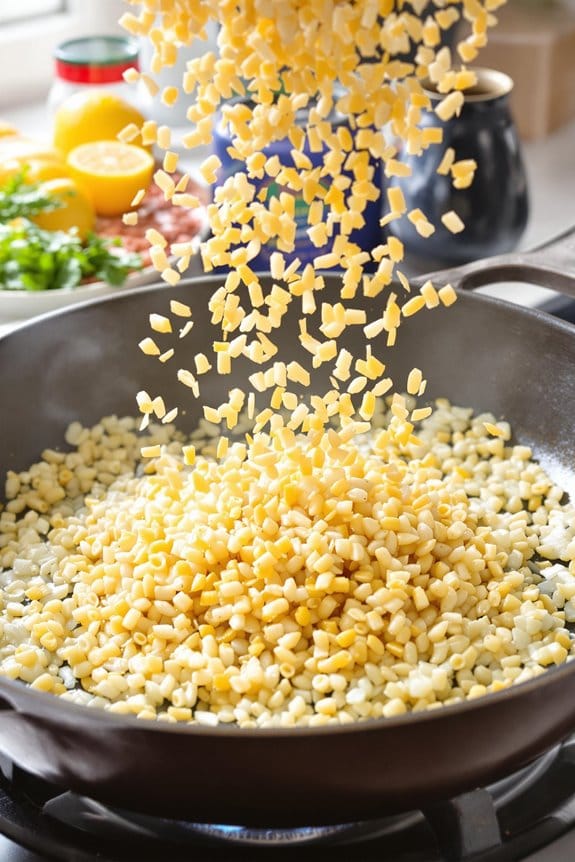
Once your rosemary and lemon zest are sizzling gently with the onions and garlic, it’s time to add the orzo.
Pour the dry orzo pasta into the skillet, stirring constantly to coat each grain beautifully in the flavorful oil mixture. This step is essential as it helps the orzo toast slightly, adding a delightfully nutty flavor to your dish.
Make sure you keep the heat on medium, and stir the orzo to prevent any grains from sticking to the bottom of the pan or burning.
You’ll notice the orzo start to turn a golden brown, which means you’re doing everything right so far, as it’s important to keep everything moving for an even toasting.
Step 5. Simmer in Chicken Broth
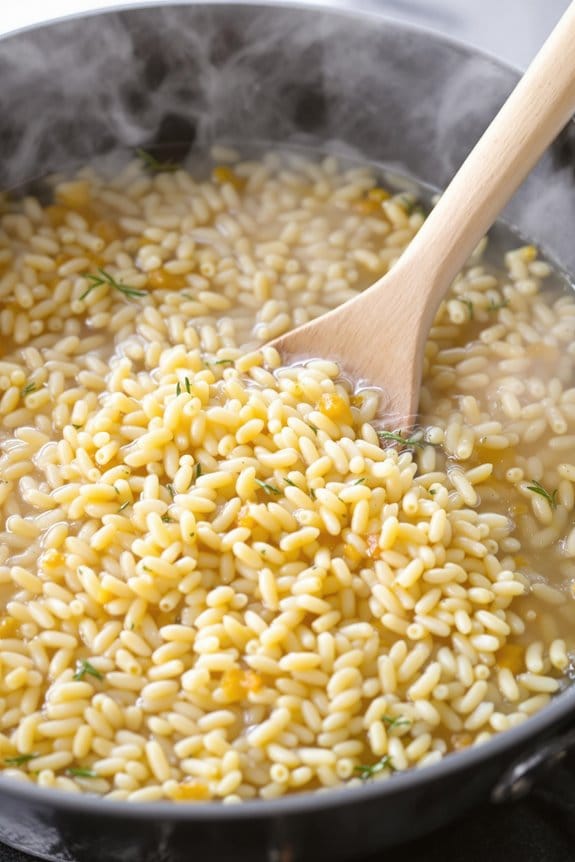
After your orzo has achieved a golden hue, pour in the chicken broth, making sure to cover all the grains. Stir gently.
Here, the simmering begins, which is essential for drawing out all the flavors. As the orzo cooks, it’ll soak up the broth, becoming tender yet firm to the bite—an al dente texture that’s perfect for absorbing the lemon and rosemary you’ll add later.
- Aromatic steam rising: soft, comforting whispers of chicken broth fill your kitchen.
- Ever-so-gentle bubbling: a soothing, rhythmic sound that promises delicious results.
- Orzo turning translucent and plump: watching each grain swell with flavor.
- Occasional stirring: a delicate dance between spoon and skillet, ensuring even cooking.
- Gradual thickening: the broth melds into a silky, rich sauce cradling the orzo.
New Recipe
- Pepperoni and Hot Honey PizzaTry the tantalizing twist of pepperoni pizza with hot honey, where sweet meets heat—how will it transform your taste buds?
Cooking Tips
Mastering the technique of toasting orzo before boiling it can greatly elevate the texture and flavor of your Lemon Rosemary Orzo Skillet. Toasting it in a dry skillet gives it a nutty depth and prevents it from becoming mushy.
After toasting, simmer the orzo slowly in chicken broth; you’ll find that this infuses each grain with a rich, savory essence centered on rosemary and citrus. Remember: stirring too vigorously can break the delicate grains, so stir gently to keep it intact.
Carefully monitor your heat as well—maintaining a consistent simmer guarantees even cooking. Adding the rosemary and lemon zest at the end retains their vibrant flavors, enhancing the final dish with freshness.
You’ll be amazed at the difference these simple steps make.
Final Thoughts
While exploring new culinary techniques, you’ve uncovered the secrets to perfecting Lemon Rosemary Orzo Skillet.
Here’s a vivid snapshot of what you can expect from your own kitchen adventure:
- The golden tint of freshly toasted orzo mingling with olive oil.
- Sprigs of rosemary releasing their aromatic oils under the gentle heat.
- Zesty lemon slices caramelizing into sweet, tangy accents.
- Crisp edges of orzo forming as you stir, adding delightful texture.
- A final sprinkle of grated Parmesan melting seamlessly into the warm dish.
Each element combines to transform simple ingredients into a comforting, flavorful skillet meal that’s as pleasing to the eye as it’s to the palate.
You’re now equipped to impress at your next dinner gathering. Enjoy the journey and the flavors!

